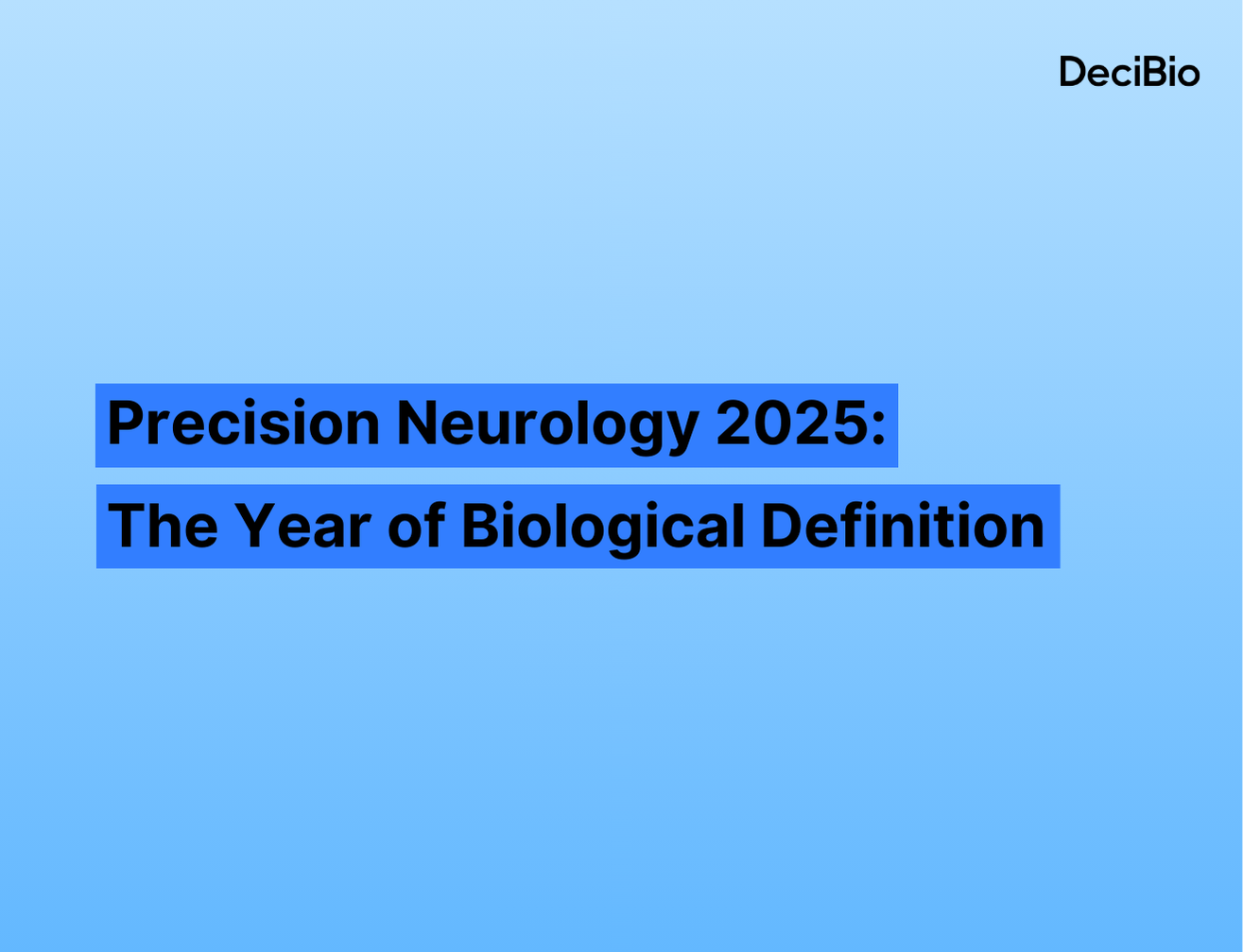Editor's Note: This article was written by Trpti Sanghvi, who was part of DeciBio's summer 2018 intern class. She will graduate in Spring 2019 with a degree in Neuroscience.Alzheimer’s Disease (AD) ranks amongst the top 10 causes of death in the United States and it is the only disease on the list that cannot be prevented, cured, or even slowed1. Currently, AD diagnosis relies on documenting mild cognitive impairment (MCI), but by the time a detectable amount of MCI has set in, Alzheimer’s has already caused a significant amount of brain damage. To overcome the effect of the delayed diagnosis, multiple biomarkers are being studied for their ability to indicate early stages and interventional measures for AD. Therapeutics are suboptimal, but even if better Dx doesn’t lead to a breakthrough therapy, it still has short-term benefits to prognosticate disease progression as well as understanding the cause of the disease.Thus, the initial aim of emerging genomic and metabolomic technologies ought to be discovering biomarkers for AD that are specific, sensitive, and predictive. An integrated diagnostic methodology, in the form of a panel of cross analyzing biomarkers, should therefore be explored as it could prove beneficial for early diagnosis, prediction, and identification of the disease.
Current Biomarker Landscape
Current biomarkers include: genetic Apolipoprotein E-ε4 (APOEε4) and Amyloid-β precursor protein; Blood-based micro RNA (miRNA), Neurofilament light protein (NFL)2, and circulating nucleic acids (CAN)3; cerebrospinal fluid (CSF) based proteins like, Beta amyloid (Aβ42) and Tau; and, positron emission tomography (PET) imaging.Genetic markers have been the most robust in predicting disease contraction. Approximately 12 miRNA types have been identified through sequencing of blood miRNA transcriptomes obtained from AD patients, MCI patients, and controls4. Blood miRNA levels of AD patients varied in comparison with controls, suggesting that development of a simplified blood test could be a method of diagnosis for Alzheimer’s. Usage of a blood-based predictive test would not only reduce the costs of the AD diagnosis process but also provide relief to elderly patients since they would not have to undergo strenuous procedures like lumbar punctures. CSF-derived biomarkers have also been studied extensively in AD, given its direct contact with the CNS. Increased levels of CSF tau have been linked to MCI patients who progressed to AD5. Further, analyzing the ratio of the CSF molecules - Aβ42 and CSF tau - has been proposed as the gold standard biomarker for AD since it helps identify the distinction between AD versus non-AD related dementia. Researchers demonstrated that a decrease in baseline CSF levels suggests a potential basis for AD diagnosis6. Thus, demonstrating that developing a framework wherein biomarkers are cross-referenced is proving to be more beneficial for diagnosis, according to our diagnostics market research.
Cross Analyzing Biomarkers
There have been several studies that have adopted the mechanism of using multiple biomarkers to cross-analyze, diagnose, and predict AD. These have been a combination of genetic, imaging, CSF, and blood-based biomarkers. To better understand – and predict -- the generation of the panel of biomarkers for AD, our diagnostics market research team conducted a network analysis spanning 13000 publications over the last 5 years. As reflected by the network map there has been a decisive shift towards multiplex biomarker studies in publications. The networks have demonstrated the evolution of a multimodal approach in AD research. Click here to explore an interactive version of the graph below.On the network, different colored dots represent authors that have listed publications which mention the four main biomarkers of interest. The biomarkers are segregated into clusters of authors that publish research papers that include these markers. Interestingly, this network not only gives us insights into the current landscape of AD biomarker research, but also predicts what the most likely biomarker panel for AD will look like in the future. For instance, the combined study of imaging and blood-based biomarkers is more popular compared to the study of blood and CSF biomarkers. However, several authors within the dataset are also exploring triple and quadruple studies with all the biomarkers listed. Therefore, we can predict that the future of AD diagnosis will include looking at a host of biomarkers for disease detection and diagnosis.

Present examples of multiple biomarker studies have included combining 16 miRNA signatures with the APOE ε4 allele; researchers were able to discriminate AD subjects from healthy subjects with 77% specificity and 87% sensitivity7. Further, another study combined both CSF proteins and genetic biomarkers; the researchers developed a logistic regression model based on CSF Aβ42, t-tau, and the APOE ε4 allele. They achieved a specificity of 79.5%, a sensitivity of 98.2%8. Lastly, statistical models have been developed which layer cluster-based networking in biomarkers with imaging results; these are used to determine how biomarker analysis can be predictive of region specific brain atrophy9. This study attempted to correlate imaging vs non imaging biomarkers; through statistical models, the authors claim that it may be possible to identify the real markers for a disease that is initially diagnosed by a surrogate marker.
Implications
The benefit of generating a multiplex biomarker panel for Alzheimer’s Disease lies in the ability to diagnose the disease early on. However, it is imperative to factor that routine clinical testing for early detection is not currently recommended for most EOAD individuals since there is, currently, no effective treatment or prevention for AD.This raises the question: what is the relationship between identifying biomarkers and a potential cure? If there is no cure, then why should early-onset identification be a priority?The benefit of disclosing Alzheimer’s early is that it allows for patients and families to plan for their future with better access to medical care and support services. In the U.S., the 2018 costs for care for AD total to an estimated $277 billion, and by 2050 these costs are projected to exceed $1.1 trillion10. Further, an earlier diagnosis could allow patients to participate in Clinical Trials to better understand disease progression and, ultimately assist in developing a cure for AD. An illustration of improved patient outcomes due to early diagnosis can be demonstrated in the case of another neurodegenerative disease – Parkinson’s (PD). Initially, like AD, PD diagnosis was dependent on patients presenting motor deficits; at this stage there has been a significant amount of neurological damage. Early diagnosis and intervention in PD has resulted in reducing symptoms, slowing disease progression, improving patient quality of life, and reducing costs associated with the disease in the long run11. Thus, early diagnosis can prove beneficial in understanding disease progression and cure in neurodegenerative diseases.Currently, AD clinical trials demonstrate promise in early stages, but have poor results for late stages. Developing better tests for patient stratification could aid in clinical trial enrichment, thereby improving success rates of AD drug trials. This would be possible if early-onset biomarkers can create a patient profile that can determine the stages of disease progression. Early diagnosis will not only allow for early intervention, but also aid in understanding the opportunities for therapeutic intervention. These opportunities can be leveraged by pharmaceutical companies, for drug development, and insurance companies, to assist with patient care and cost management. AD dominates in the costs incurred for patient care thus, it is imperative to understand that diagnostic research is impactful; it can aid in explaining the mechanism of action of the disease, which would open opportunities for the development of additional therapeutics.Biogen is promising a drug in 2019 that will assist with slowing progression of cognitive decline. Further, large pharmaceuticals like Roche resorted to cross-analyzing CSF and imaging biomarkers to better diagnose AD. They have received FDA breakthrough designation for their Elecsys CSF Assays12. Thus, funding initiatives for research is imperative to drive significant growth for the development of methods for better understanding the disease. Lastly, Venture Philanthropy efforts like the Diagnostics Accelerator - introduced by Bill Gates and the Alzheimer’s Drug Discovery Foundation13- are making Alzheimer’s diagnosis and cure a possibility in the foreseeable future.
References
- https://www.alz.org/alzheimers-dementia/facts-figures
- https://www.ncbi.nlm.nih.gov/pubmed/30055655
- https://www.ncbi.nlm.nih.gov/pubmed/30032422
- https://www.ncbi.nlm.nih.gov/pmc/articles/PMC5357660/
- https://www.ncbi.nlm.nih.gov/pmc/articles/PMC5357660/
- https://www.ncbi.nlm.nih.gov/pmc/articles/PMC5357660/
- https://www.ncbi.nlm.nih.gov/pubmed/25349172
- https://www.ncbi.nlm.nih.gov/pmc/articles/PMC2696350/
- https://www.nature.com/articles/s41598-018-21118-1#MOESM1
- https://www.alz.org/alzheimers-dementia/facts-figures
- http://eprints.lse.ac.uk/68479/1/The_value_of_early_diagnosis_and_treatment_in_Parkinson%27s_disease_author.pdf
- https://www.roche.com/media/releases/med-cor-2018-07-20.htm
- https://www.gatesnotes.com/Health/A-better-way-of-diagnosing-Alzheimers






